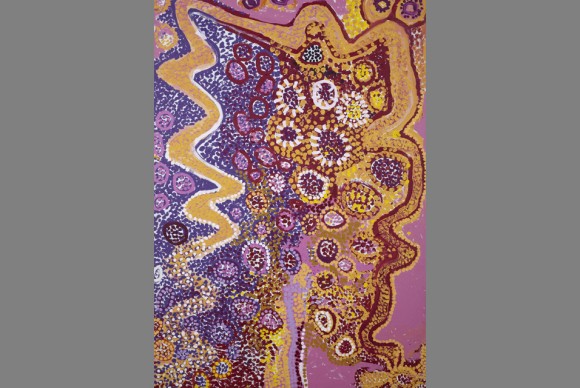The Valencian Institute for Modern Art opens exhibition: Contemporary Indigenous Art in Australia
February 1, 2012 by All Art News
Filed under Art Events & Exhibitions
VALENCIA.- The director of the IVAM, Consuelo Císcar, the curators of the exhibition Ian McLean and Erica Izett and artists Judy Watson and Christian Thompson presented the exhibition “Contemporary Indian Art Australia. Missana-Sordello Collection, which will run until April 16 . The exhibition draws primarily from the private collection of Marc Sordello & Francis Missana and brings together 71 works from 58 artists that are part of Western Desert, a movement that brings together indigenous artists from the communities of the almost desert of Western Australia . The exhibition also includes the work of indigenous artists who are part of today’s urban culture as Christian Thompson and Judy Watson.
This exhibition is mainly drawn from a private collection of Western Desert painting, most of which has been made during the previous five years, by which time the art movement was well established and the artists confident in their practice as professional artists.
Generally Western art is exhibited in the generous plush rooms of fine art museums whereas Indigenous art is relegated to the crowded hangs of anthropology and natural history museums, as if the former is the palace of the future and victory, and the latter the mausoleum of the past and defeat. However, the changing face of contemporary art and particularly the pressures of globalization are opening the artworld to Indigenous art as a contemporary practice fit for exhibition in fine art spaces. In Australia this has been the case for more than twenty years.
Less than 3% of Australians are indigenous. Of these, about 80% live in urban areas, and 20% reside in sparsely populated remote Australia near or on their country. Most Indigenous art is made in remote Australia, and is part of a lively hybrid culture that combines Indigenous and Western traditions. The breakthrough for Australian Indigenous artists occurred in the 1980s and 90s, when large acrylic paintings on canvas from communities in the Western Deserts attracted the attention of the artworld and, before long, a lucrative market.
The remote settlements that dot the Western Deserts typically consist of several hundred to a thousand closely related inhabitants. Compared to more urbanized cities and towns in Australia, they have the highest proportion of Indigenous Australian and Australian born-residents, females, births, younger people, unemployment, funerals and chronic disease such as diabetes and glaucoma, and the lowest proportion of home-computer use. Mobile telephones, however, are endemic. As well, per head of population, they are serviced by more cultural and art centres, and have the highest proportion of professional artists anywhere in the world.
Remote Indigenous art is mainly practiced under the auspices of senior Lawmen and women who have deep knowledge of Indigenous traditions. While deeply immersed in their culture and responsibilities, many of these artists know about Western contemporary art through books, travel to fine art museums and their contacts with Western artists and the artworld more generally. Nevertheless, their art is primarily an assertion of Indigenous values. It might resonate with the formal energy of Western contemporary art and echo Western artworld concerns about identity, place, affect and language in today’s changing world – and this is what makes it contemporary art – but it is conducted on its own terms even when collaborations and workshops are undertaken with Western artists.
The exhibition also includes the work of two urban-based Indigenous artists. Unlike the remote artists, many urban artists have been educated in university art schools and directly engage with mainstream artworld discourse. While urban Indigenous art reflects the Western traditions taught in Australia’s universities, invariably it also connects with Indigenous perspectives on the histories of colonization and globalization – as indeed much non-Indigenous Australian does. The artworld success of both remote and urban Indigenous art but also the extent to which they are and remain subcultures within mainstream contemporary art, are a telling barometer of the changing world in which we live.
Related posts:
- Valencian Institute for Modern Art Opens “Mean Streets” Exhibition
- Valencian Institute of Modern Art Opens Exhibition by Ximo Lizana
- Valencian Institute for Modern Art exhibition opens with the work of José Manuel Ciria: The Last Decade
- Valencian Institute of Modern Art opens exhibition of the sculpture of Arturo Berned
- 6th Asia Pacific Triennial of Contemporary Art Opens in Australia

